I’ve mentioned before that raptors, especially buteos, often signal imminent takeoff with one or more of four distinct behaviors – rousing, a wing stretch, pooping and turning and/or looking into the wind (in any order). This bird gave me three of the four so I’d have had to be asleep to have missed the takeoff.
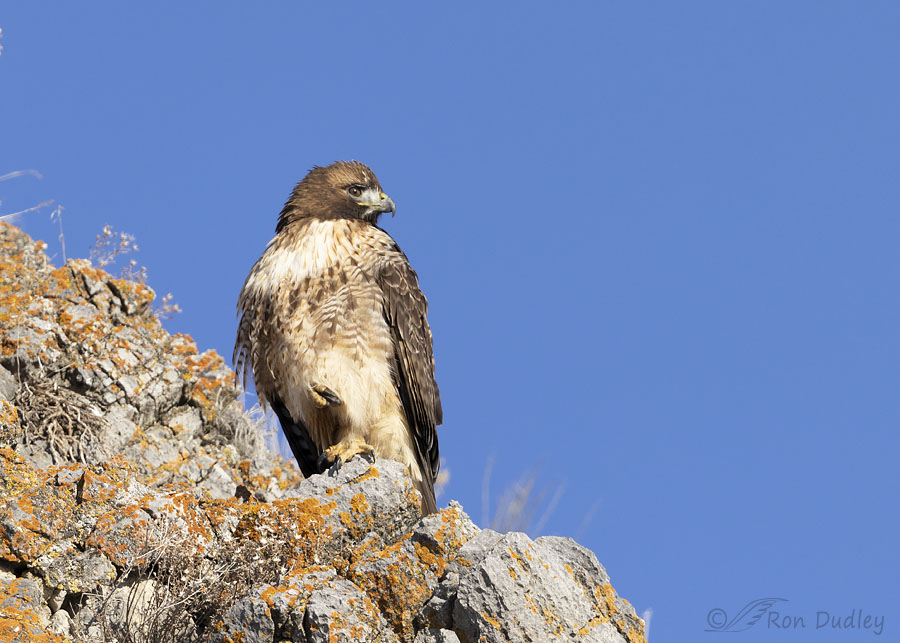
1/2500, f/5.6, ISO 400, Canon R5, Canon EF500mm f/4L IS II USM + 1.4 tc, not baited, set up or called in
Five days ago I found this adult Red-tailed Hawk perched near the top of some lichen-covered rocks. While ‘he’ was perched the shooting angle was a little steeper than I prefer but when they take off from an elevated perch you never know how that angle might be modified in flight so I watched him through my viewfinder and hoped for the best.
For most of the time he was facing to my left but when he started staring over his left shoulder, the direction the breeze was coming from, I wondered if he was thinking of taking off. He could have been just scanning for prey in that direction but I prepared myself for takeoff, just in case.
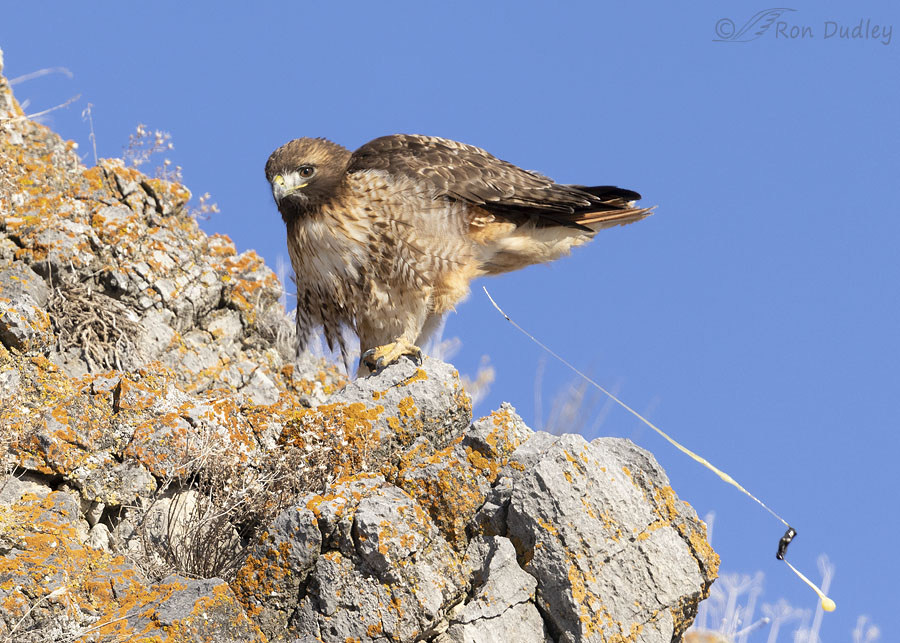
1/3200, f/5.6, ISO 400, Canon R5, Canon EF500mm f/4L IS II USM + 1.4 tc, not baited, set up or called in
But then he pooped so I knew he was likely to take off, and soon.
And what a poop it was – a couple of feet long with a dark clump of digestive waste near its end. The white stuff is uric acid, a metabolic waste. Their cloaca, the chamber where both types of wastes are mixed, doesn’t mean “common sewer” for nothing.
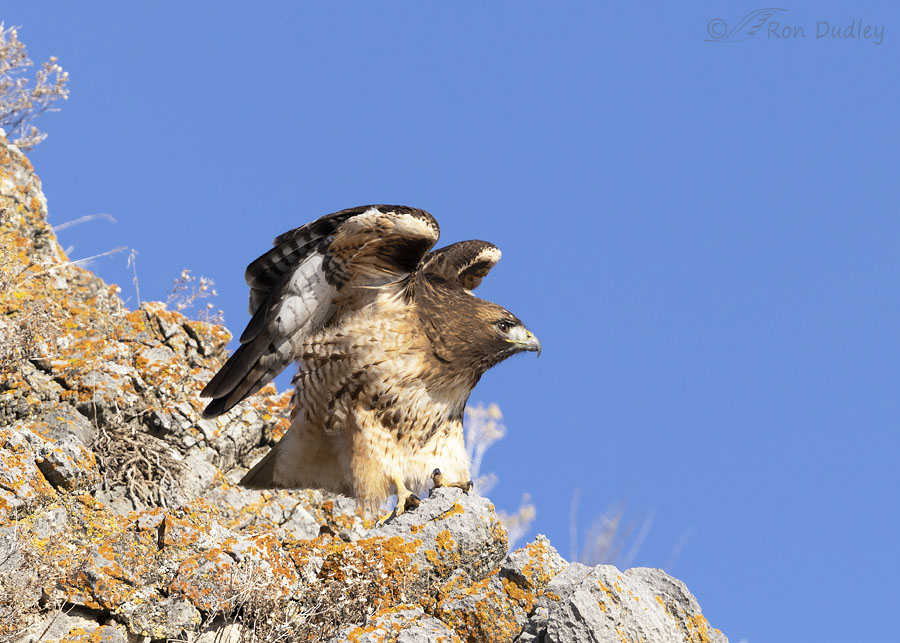
1/3200, f/5.6, ISO 400, Canon R5, Canon EF500mm f/4L IS II USM + 1.4 tc, not baited, set up or called in
Sure enough, he then began to turn his body into the breeze as he was performing a wing stretch. By now I was primed for takeoff.
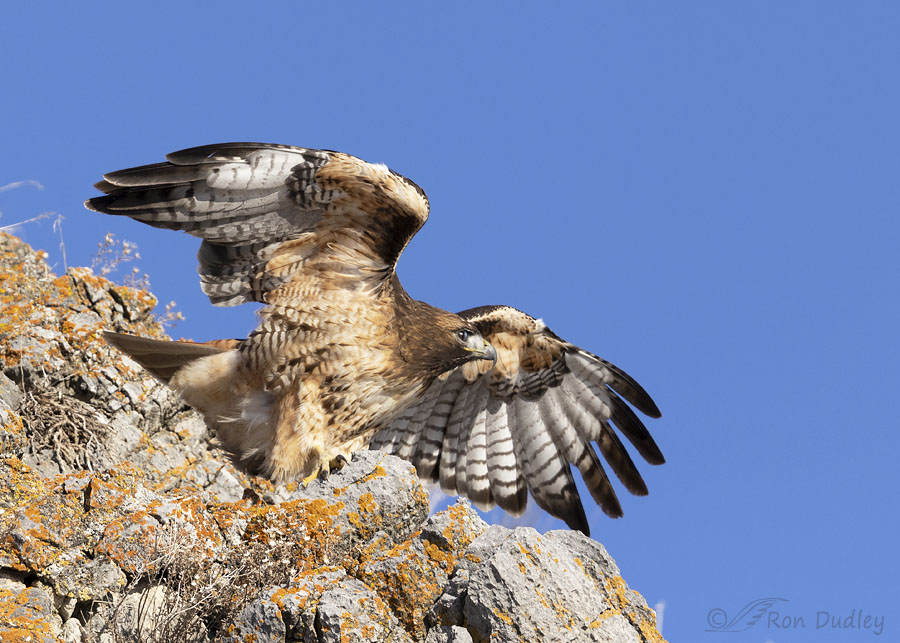
1/3200, f/5.6, ISO 400, Canon R5, Canon EF500mm f/4L IS II USM + 1.4 tc, not baited, set up or called in
I quite like this pre-takeoff shot, even though his nictitating membrane is partially closed.
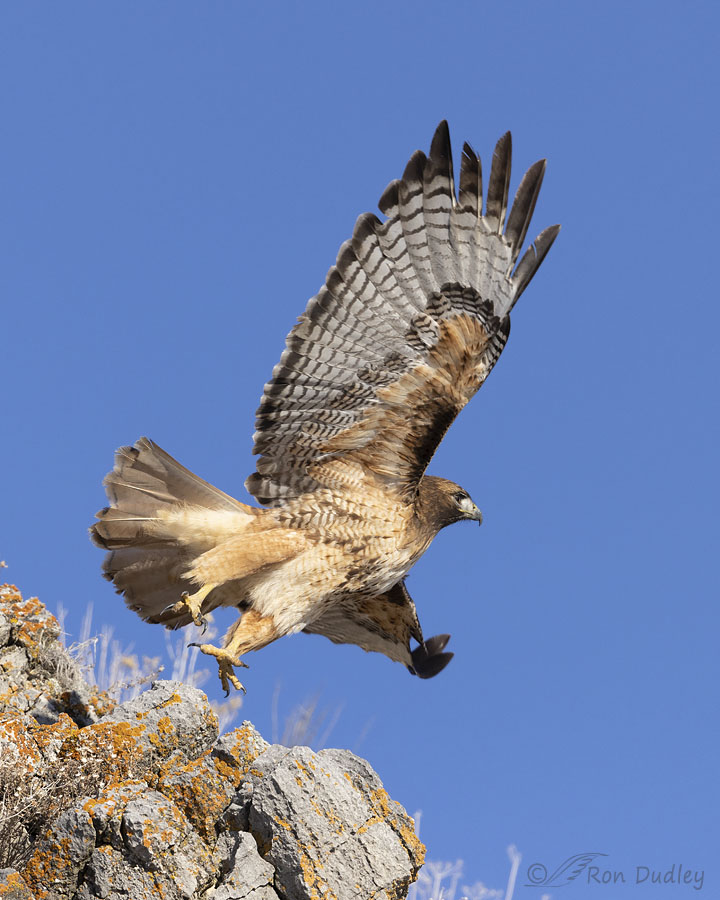
1/4000, f/5.6, ISO 400, Canon R5, Canon EF500mm f/4L IS II USM + 1.4 tc, not baited, set up or called in
And then he was gone, or almost so. I’d have liked this photo better if he wasn’t looking away from me but what could I expect – that’s the direction the breeze was coming from and the direction he’d been looking prior to takeoff.
Every bird photographer has missed takeoffs and subsequent flight when they weren’t prepared when the bird launched. When this bird took off the only thing missing from the pre-takeoff regimen was a rouse, so if I’d have missed his launch I’d take it as a sign that it was time for me to retire my camera gear and take up knitting.
Thankfully I’m not there yet.
Ron


What a handsome RTHA! That is one “pooperrific” shot — from both of you!
Looks like the wind wasn’t hitting him directly in the face. I notice that his left wing’s primaries are curved and alula is out, while the right wing’s aren’t (although he does have one primary that hasn’t finished growing in on the right). Look at all the things I now notice thanks to your educational posts — ya done good, Teech!
Thanks, Marty. Details. It’s all about details!
I think Mark said it all — “Holy crap…great series Ron!”
(But may I add … that’s a poop shot for the record books, I think. AND what a gorgeous hawk.)
Thank you, Chris.
Cathy Royal Orullian, of my favorite ex-students from back in the day, had this to say about that poop shot on Facebook. Cathy always had a way with words…
“I have never, nor will I ever, see a better shot of poop! Wow!!”
Wow..! what a beautiful pictures ! Mr Ron I am artist panting on feathers , would you give me permission to paint some of your beautiful photos ?
Thank you, Patricia.
I’m afraid I won’t be “giving” you permission to paint any of my photos. I checked out your website when you tried to make your first comment a couple of days ago and I see that you charge as much as $7500 with Bitcoin for your paintings, maybe more – I didn’t look at all of them.
http://marinfeatherart.com/original-works/spirit-of-the-buffalo-dance/
There’d be licensing fees involved for you to use my photos.
Edit: Not long after I posted this comment Patricia’s website suddenly and mysteriously stopped working so the link above isn’t working either.
2nd Edit: It’s working again now.
HA! Amazing how that works………
Great capture and photos. Now will you observe mergansers and give me your take? I have really enjoyed them this year but they are a bit different. I’ve got the dive sequence mostly understood and behavior after eating but the take off is hard. they tend to stretch up their head and neck then just shoot off the water. Very fast, little notice. I don’t have a single decent shot despite many tries. they don’t seem to run on the water as far as other diving ducks either. They are a torpedo in the water and air.
April, I’m afraid I won’t be much help for the type of merganser shot I think you’re talking about – takeoff from pretty close. They’re just too fast and give very little if any indication they’re about to take off.
The best luck I’ve had with them is from further away so I have more room in the frame. With my, and your, R5 the file size is large enough to crop a lot and still have good detail. The R5 does a good job of keeping them in focus too.
Your knowledge of these take off behaviors is testimony to your hours and years of observing and patiently paying attention. As Kris and other have said, every post is an opportunity to learn a little more. Usually about birds and often something else.
Thank you, Lyle. When you’ve spent as much time as I have doing stuff like this you’d have to be dead to not learn something.
Now that is a classic poop. I have never seen one that good. What excellent take off photos. Yours were always good, but now with the R5 I think even better. When I do something really good my wife gives me 5 Stars. For this series I am giving you 5 Stars. Outstanding Ron.
Just curious – these are obviously the best, but roughly how many shots were taken?
Thanks, Everett. I took 65 shots of him while he was perched and taking off and then 12 more while he was in flight. The flight shots are no good because he was flying mostly away from me.
NICE! “He” certainly did give you some warning AND, of course, you knew what to watch for.
Even with the nictitating membrane half close that eye is certainly sharp! Wouldn’t have wanted to be behind him when he cut loose!
“Wouldn’t have wanted to be behind him when he cut loose! ”
I HAVE been behind them when they’ve cut loose, Judy. I used to arrange to have education birds in my classroom and more than once I’ve been behind one when it sliced. I kind of expected it might happen but I knew my students would get a huge kick out of it if it got me, or nearly did, so I took the chance. And lost.
I’ll just bet the students, particularly the boys, got a REAL laugh out of it! Whatever it takes!
Whatever it takes!
Had a German teacher at our highschool that always told the students the boys would do better than the girls as they liked to make “funny noises”
Judy, the boys would laugh and the girls were mostly grossed out but the reaction of all of them was strong.
Wow, he really telegraphed that take off. Classic.
Love the view of the underside of the right wing on that last shot.
Thanks, Michael.
Wow– what a good look at the underside of the right wing that last shot provides– just glorious ! Until today, I’d thought that “mixed waste”
was a phrase used only at recycling operations…….every day, I learn
something interesting and unexpected from F.P. !
“every day, I learn something interesting and unexpected from F.P.”
Very good to know, Kris. Thank you.
Holy crap, what a great series Ron! He’s a beautiful hawk.
Holy crap indeed. Thanks, Mark.